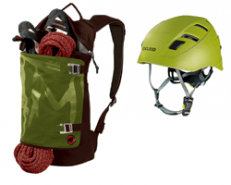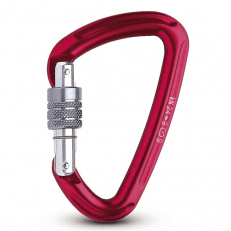Safety
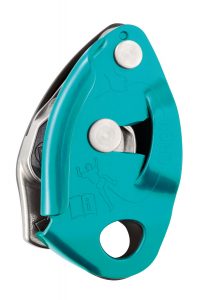
Safety first is really much more first when you are 10 meters or higher up in the air falling is not an option. Injuries, luckily, don’t happen often in climbing, but when they do they are relatively much more serious and even fatal than many other sports.
With the advent of belay devices, the risk of a fall is very much reduced. With a such a device, your climbing partner can secure you as both your climbing harnesses are connected through your climbing rope. Through friction on the rope, your partner can block he rope when you fall. And at the end of the climb belay you down again.
Passive belay devices
A passive belay devices requires action from the belayer to lock the rope in the event of a fall. One of the most traditonal of such devices is the “Eight”.
An eight is the simplest and for a long time was by far the most commonly used tool for securing someone. The rope is pulled through the eight-form so that as it moves along the steel, friction is induced. So much so that with minimal effort the rope can be locked. In addition to belaying it can also be used for rapelling.
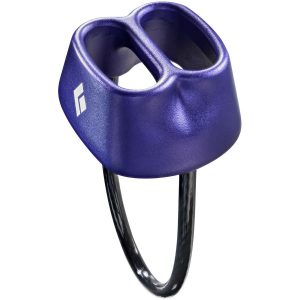
Another good example of passive device is the ATC belay device. One of the many tubular devices that also relay on action from the belayer to lock the rope.
Active belaying devices
The most well known of these devices is the GriGri. This kind of device has a built-in mechanism that locks off the rope automatically when the rope slips at high speed through the mechanism. A very safe device but one that can lead to less alert belayers. So whichever device you use, the life of your climbing buddy is, quite literally, in your hands!
Carabiners
Carabiners are metal loops that connect everything together. Most often made from aluminium alloy and with spring-loaded gates (openings). There are several types of carabiners, such as: ordinary carabiner, HMS carabiner, twistlock (quick release), etc. The choice of karabiner depends on what you are going to use.
For the belayer, a curved karabiner is the most convenient due the larger top side. HMS carabiners can carry 3-sided loads instead of 2-sided and are therefore suitable for anchors with weight pulling in different directions.
Image Salewa Hot G2 Screw karabiner
A good carabiner should:
- have an ideal ratio between weight and breaking force (minimum standard is 2000 kg)
- not slip out of your hand to easily.
- open and close smoothly
- not have any sharp edges that can damage yourself or your rope
Climbing harnesses
 If you intend to use the harness often in the high mountain, choose for lined and adjustable leg loops Lined harnesses have less stress on your legs and are more comfortable when you wear them over longer periods of time.
If you intend to use the harness often in the high mountain, choose for lined and adjustable leg loops Lined harnesses have less stress on your legs and are more comfortable when you wear them over longer periods of time.
Adjustability is important to fit the leg loops to thicker or thinner clothes.
Image: Arc’teryx B 360a Men’s
If you focus mainlyon sports climbing on rocks, choose the comfort of a wide, possibly padded hip belt with or without polished leg loops. For indoor climbing there are special ultra-light belts.
There are two types of harnesses:
Reguar hip harnesses
The most widely used, they are preferred choice due to their comfort and greater freedom of movement.
Full body harnesses
This also has shoulder straps, and are safer as the point where the rope is attached is higher than the climber’s center of gravity, reducing the risk of a back injury in an uncontrolled fall.
Climbing shoes
Without getting to technical as far as climbing technique is concerned, we can state that your legs and feet are the foundation of your climbing. So your shoes are essential to your effort.
On the smaller footholds you will encounter, you will generally climbin with the edge of your shoes, a lot of which will be on the toe edge (this is called “edging”). That means the soles of climbing shoes need to add to the stability of your foot. Climbing shoes will generally have quite a stiff vulcanized rubber sole that adds this much needed stiffness. Besides that, the rubber also delivers heaps of friction on the wall. In the climbing technique know a “smearing” where you climb on friction rather than on the edges of your shoes, mostly because there are no footholds.
Given that climbing shoes need to add stability and stiffness to your foot, you will generally need to buy shoes that fit quite snug, if not really tight. It should not be painful.
There are three categories of shoes:
Neutral:
These shoes have a relatively relaxed and straight footbed. Your toes are straight in the shoe. The fit is more comfortable and relaxed, making them great for beginning climbers or for more experienced climbers doing all day climbs. The sole is thicker and stiffer.
Moderate:
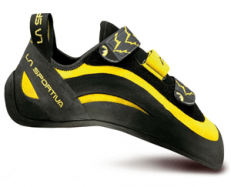
The shape of these shoes is slightly downturned with a light camber in them. There is more pressure to your toes, enabling you to climb more technical and challenging routes with smaller footholds. Stickier rubber and slightly thinner soles for more grip and feel.
Aggressive:
Shoes with a very strong camber to them and a lot of tension on your foot directed to the toes. Not very comfortable, but very good for those really difficult routes. Again stickier and thinner soles.
Take your time to choose what kind of shoe would fit your foot, but also the kind of climbing you do.
Climbing ropes
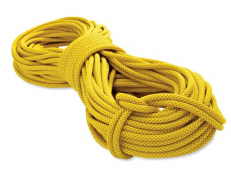 A good rope is essential for climbing. These kind of ropes are not only very strong, but also slightly elastic to absorb a part of the force of a fall. This especially true for so called dynamic ropes that are used for top roping or lead climbing.
A good rope is essential for climbing. These kind of ropes are not only very strong, but also slightly elastic to absorb a part of the force of a fall. This especially true for so called dynamic ropes that are used for top roping or lead climbing.
Image: Mammut Tusk Dry klimtouw
The ideal climbing rope combines the following properties: it will be strong, light, abrasion resistant, flexible, easy to use, low strain when body weight, low retention.
There are many variations in rope diameter and length, as well as safety ratings. This will indicate what kind of climbing the rope is good for.
Static ropes are ropes that have less elasticity and are used for ascending on a rope, or pulling expedition materials up a rock face, or any situation in which you do not want the rope to stretch.

